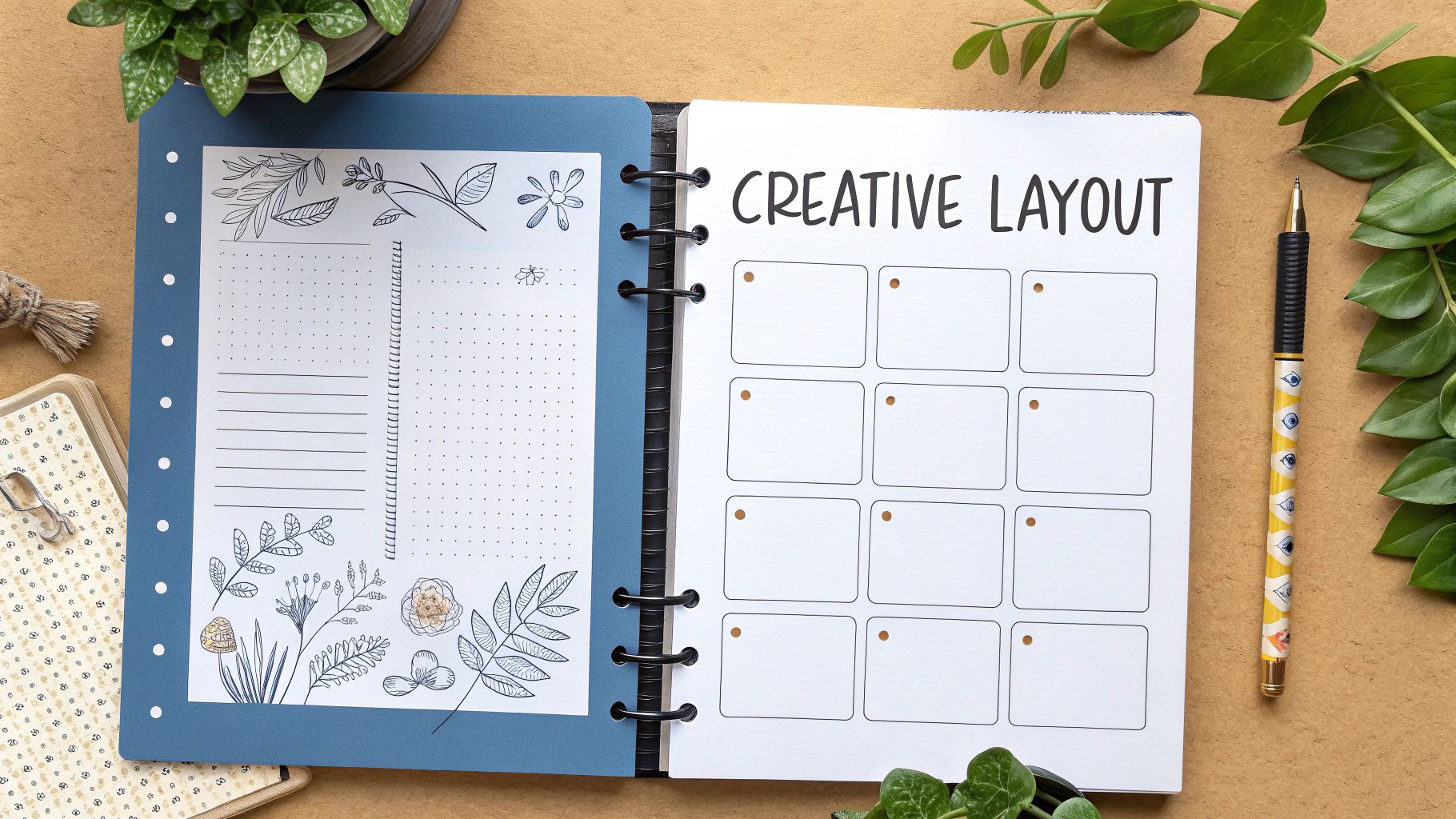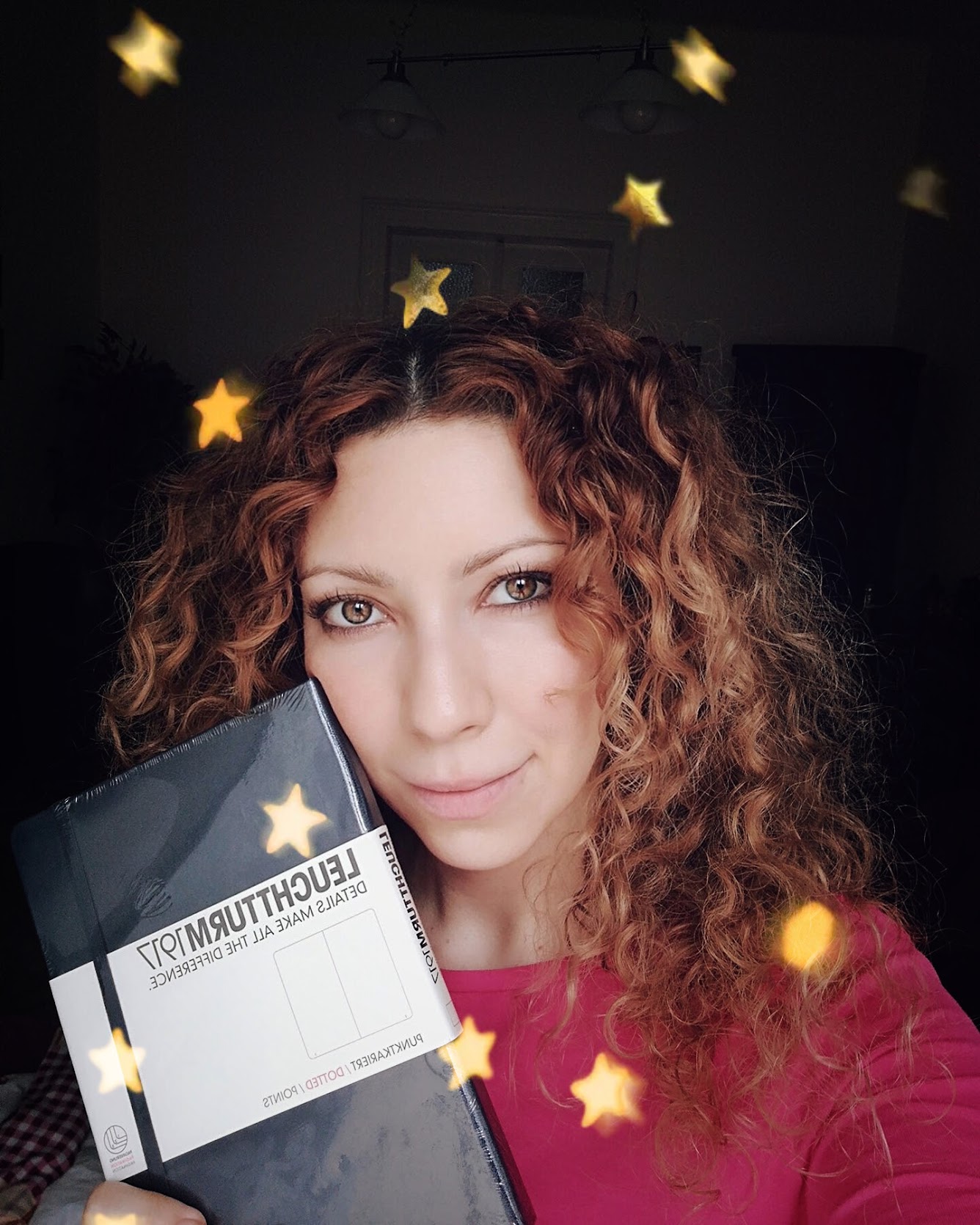
That first blank page of a new bullet journal can feel a little intimidating. It’s normal to wonder where to begin. But understanding the basic elements of a good bullet journal setup can ease those first-page jitters and put you on the path to productive journaling. Let’s explore these essential components, covering everything from finding the right notebook to creating your index and future log.
Choosing the Right Notebook
Picking the perfect notebook is the first big step. This goes beyond just looks; it’s about a notebook that truly fits your lifestyle and journaling style. Think about size, paper weight, and how it’s bound. Do you need something small for journaling on the go, or would you prefer a larger size for detailed spreads? For some more tips, check out this helpful resource: How to master your Bullet Journal Setup.
For example, an A6 notebook is great for quick notes, while an A5 provides lots of space. The paper should be thick enough so ink doesn’t bleed through, particularly if you enjoy using markers. A strong binding will keep your journal intact through everyday use, forming a solid base for the organized system you’ll build within.
Setting Up Your Index and Future Log
Once you’ve chosen your notebook, the next step is setting up some key organizational pages: the index and future log. These are fundamental to the bullet journal method. The index works like a table of contents, helping you find specific entries fast. As you add to your journal, simply note the page number and a short description in your index.
The future log gives you a broad overview of what’s coming up: events, deadlines, and appointments. It’s like a master planner where you can jot down important dates that aren’t yet part of your monthly or weekly spreads. This helps ensure nothing important gets overlooked. This big-picture planning complements the more specific daily and weekly organization that follows. Bullet journaling is popular because it’s flexible and personalizable. Many people spend a lot of time, sometimes 80-90%, on their daily and weekly spreads. This allows for detailed daily and weekly planning, which is key for staying productive and mindful. You can learn more about bullet journaling here: Learn More About Bullet Journaling.
Avoiding the Perfectionism Trap
Remember, your bullet journal is a tool for you. Don’t feel pressured to create perfect spreads. The real power of bullet journaling is in its adaptability. Start simply, try different layouts, and see what works best for you. Accepting imperfections is all part of the process, letting you grow and develop a journaling practice that you can stick with. This mindset sets you up for success in the long run and helps avoid the burnout that can come from trying to reach impossibly high standards.
Monthly Layouts That Drive Real Progress

Monthly spreads form the core of a successful bullet journal. They provide a vital overview of your upcoming month, helping you plan effectively and stay organized. Finding the right balance between a beautiful spread and a functional one can be tricky. This section explores some well-tested monthly layouts that can help maintain momentum in your bullet journal throughout the year. These layouts will give you a solid structure to integrate your schedule, track goals, manage tasks, and smoothly transition between months.
Designing Calendar Systems
A practical monthly calendar is essential. Think about how you use a calendar in your daily life. Do you need lots of space for each day’s entries, or is a simple overview enough? Play around with various calendar styles, such as the traditional grid layout, a vertical list, or even a circular calendar. Each format offers different ways to visualize your time. A vertical list is great for tracking deadlines, while a circular calendar can be better for seeing cyclical patterns.
Consider linking your digital calendar too. Many bullet journal users combine their physical journal with digital calendar apps like Google Calendar. This lets you leverage the strengths of both: digital for reminders and sharing, and physical for personalized planning and reflection.
Bullet Journal Setup 101: Integrating Goal Trackers
This is where the real power of a bullet journal comes in. Adding goal trackers into your monthly spread keeps your goals visually front and center. A simple checklist of key goals will do the trick, but you can also get creative with visual trackers using bars, graphs, or even small drawings.
You could track your fitness goals, for instance, by marking each day you exercise. Or maybe you’re working on a big project at work – fill in a bar graph as you reach each milestone. These visual cues keep you motivated and make it easy to see your progress throughout the month. Monthly setups are essential for effective bullet journaling. Calendar layouts often help visualize events and deadlines, keeping users organized with appointments and tasks. A monthly overview could include important dates like birthdays and other events, allowing for proactive planning. Want more tips on monthly setups? Discover More Insights About Monthly Setups.
Task Management Strategies
Good task management within your monthly spread is key to avoiding feeling overwhelmed. Set aside a specific area in your spread for listing important tasks, and break down large projects into smaller, manageable steps. This helps you prioritize and focus your energy on what’s truly important. For helpful supplies, check out: Everything You Need for Your Bullet Journal.
Seamless Monthly Transitions
Smooth transitions between months are a key element of a well-maintained bullet journal. Develop a consistent structure for your monthly spreads to minimize setup time. Consider using templates or reusable elements like pre-drawn calendars or habitual trackers. This maintains continuity and helps you quickly get organized each month.
Less setup time means more time actually using your bullet journal. By simplifying the transition process, your bullet journal continues to be a tool for progress, not another chore.
To help you explore some monthly spread options, here’s a comparison table:
Here’s a handy table to compare some popular layouts:
Popular Monthly Spread Layouts:
Comparison of different monthly layout styles with their benefits and drawbacks
| Layout Style | Setup Time | Space Required | Best For | Limitations |
|---|---|---|---|---|
| Calendar Grid | Low | Medium | Visualizing the whole month, scheduling appointments | Limited space for daily tasks |
| Vertical List | Low | Low | Tracking deadlines, simple overview | Not ideal for complex schedules |
| Horizontal Calendar | Medium | High | Lots of space for daily tasks, detailed planning | Can be time-consuming to set up |
| Circular Calendar | Medium | Medium | Visualizing cyclical patterns, habit tracking | May not be suitable for linear scheduling |
| Dutch Door | High | High | Maximum flexibility, combining different elements | Requires more setup time |
This table summarizes the key benefits and drawbacks of each layout style, allowing you to choose the best one for your needs. The Calendar Grid is quick to set up and provides a good overview, but may lack space for daily tasks. The Vertical List is simple and space-saving but not ideal for complex scheduling. The Horizontal Calendar offers lots of space for daily planning but requires more setup time. The Circular Calendar is great for visualizing cyclical patterns but may not suit linear scheduling. The Dutch Door offers maximum flexibility but requires the most setup time. Ultimately, the best monthly layout is the one that works best for you.
Weekly and Daily Spreads That Actually Work

The heart of any successful bullet journal lies in its weekly and daily spreads. These are the pages where your big ideas become actionable steps. This section explores different layouts, from simple designs to more detailed spreads. We’ll focus on how effective bullet journalists adapt their pages to fit their real lives, not just picture-perfect Instagram posts. We’ll learn how to find the sweet spot between structure and flexibility, handling both scheduled appointments and life’s little surprises.
Finding the Right Balance: Structure vs. Flexibility
A common mistake when setting up a bullet journal is creating spreads that are too rigid. While structure is important for staying organized, too much can backfire. For example, scheduling every hour of your day might look impressive, but it can lead to frustration when things inevitably come up.
A better approach is to build a framework that can be adjusted. Instead of hourly blocks, try timeboxing. This means allocating time slots to tasks but allowing for flexibility throughout the day. This balance keeps you organized while acknowledging that life doesn’t always go as planned.
Practical Layouts for Weekly Spreads
There’s no single perfect layout for weekly spreads. The best one depends on your own needs and preferences. Here are a few popular options:
- Vertical Layout: Divide the page into columns for each day, creating plenty of space for daily to-dos and notes.
- Horizontal Layout: Use rows for each day, giving you a clear overview of the entire week.
- Dutch Door Spread: Make a fold-out section for extra notes or a running task list for the whole week.
- Combination Layouts: Mix and match elements from different layouts to create a personalized spread.
For more inspiration, check out this helpful resource: How to master weekly spreads.
Maximizing Daily Productivity: Task Migration and Prioritization
Effective daily spreads do more than just list tasks. They use techniques like task migration, moving unfinished tasks to the next day so nothing gets forgotten. This keeps important items front and center until they’re completed.
Prioritization is also essential. Use symbols or color-coding to highlight high-priority tasks, helping you focus your energy effectively. This visual system lets you quickly spot the most important items on your list, boosting your daily productivity.
Adapting Your Spreads During High-Stress Periods
Life has its ups and downs. During stressful times, even the best-laid plans can feel overwhelming. The key is to adapt, not give up. Simplify your spreads during these periods. Concentrate on essential tasks and reduce the level of detail.
For instance, swap detailed daily spreads for a simple running task list for the week. This streamlined approach maintains a sense of order without adding to your stress. Remember, your bullet journal should be a helpful tool, not another source of pressure.
Integrating Time Blocking for Enhanced Focus
Time blocking can dramatically improve focus and productivity. Assigning specific time blocks for tasks, you create a structured day. This reduces multitasking and allows for dedicated time on important projects. For example, block out 9 am to 11 am for deep work, followed by a break, then a block for emails or meetings. Time blocking helps you control your schedule and engage more deeply with your work. Play around with different time blocking methods to find what works best for you.
From Intention to Action: The Power of Consistent Review
The success of any bullet journal, particularly its weekly and daily spreads, hinges on regular review. Consistently reviewing your progress, migrating tasks, and adjusting your approach is key to staying on track. This reflection helps you identify what’s working, what needs tweaking, and how to tailor your spreads to your evolving needs. Regular review transforms your journal from a static notebook into a dynamic tool for personal growth and productivity.
Habit and Mood Trackers That Drive Real Insights

A truly effective bullet journal goes beyond aesthetics. It’s about incorporating trackers that help you understand yourself better. These trackers shouldn’t add pressure; they should reveal meaningful patterns in your habits and moods. The goal is to build a system that encourages consistency, not guilt. Let’s explore how to create trackers that provide valuable insights and support your well-being.
Creating Visual Feedback Mechanisms
Visual feedback is incredibly motivating. Think of progress bars in video games or fitness apps – the sense of accomplishment they provide. You can apply this same principle to your habit trackers. Use simple visual cues like checkmarks, color-coding, or even little doodles to represent completed tasks. Visualizing your progress reinforces positive routines and keeps you engaged. For example, tracking your water intake by filling in a water droplet for each glass can be surprisingly satisfying.
Identifying Correlations Between Tracked Elements
The real magic of tracking lies in connecting the dots. When tracking multiple elements – sleep, mood, and productivity, for example – you can see how they interact. You might notice that less sleep leads to a lower mood and decreased productivity. These correlations provide valuable self-awareness, helping you understand the factors that impact your well-being. Some people integrate trackers directly into their monthly spreads, using symbols or colors for completed tasks. This provides a visual reminder and encourages consistency throughout the month. Want to learn more? Check out this helpful resource: Learn more about Monthly Habit Trackers. This interconnected approach gives you a holistic view of your habits and their impact.
Practical Approaches for Simplifying Data Collection
Tracking shouldn’t be a chore. During busy times, simplify your methods. Instead of detailed entries, try a simple “yes/no” system or a single symbol for completion. This minimizes the time commitment while still providing useful data. This flexible approach ensures your bullet journal stays a supportive tool, not another burden. Here’s a great resource for different layouts: 8 Effective Habit Tracker Bullet Journal Layouts. This way, your bullet journal remains a consistent part of your routine, even when life gets hectic.
Adapting Your Trackers as Habits Evolve
Your needs and goals change, and your trackers should too.

Experiment with different layouts and tracking methods. As habits become ingrained, consider simplifying or even phasing out trackers. This prevents your bullet journal from becoming cluttered and keeps it focused on your current priorities. This adaptable approach ensures your bullet journal stays relevant and helps you maintain momentum.
Using Data to Improve Well-being
The data you gather is more than just checkmarks. It’s a valuable resource for self-improvement. Regularly review your trackers to identify areas for growth and celebrate your successes. This reflection helps you understand your habits and empowers you to make positive changes. This data-driven approach transforms your bullet journal into a powerful tool for personal growth.
Creating Collections That Serve Your Actual Life
A bullet journal is so much more than just monthly and weekly spreads. Its real strength lies in collections: dedicated pages for specific parts of your life. Think of them as mini-journals within your journal! This section explores how seasoned journalers create and use these collections, making them valuable tools instead of forgotten pages. We’ll look at how to strategically design collections that work with your main spreads and how to keep them active and relevant every day.
Designing Effective Collections
A good collection starts with a real need. What areas of your life could use better tracking or planning? Maybe it’s books you want to read, ongoing projects, or even your finances.
A reading log, for example, can track your progress, genres you’ve explored, and even offer space for mini-reviews. A project planner can help you break down big tasks into smaller steps, set deadlines, and monitor your overall progress. A financial tracker can help you keep an eye on your spending, budget effectively, and work toward financial goals.
Reading logs and trackers are especially popular with bookworms. These logs can help you track how many books you’ve read, the genres you’ve explored, and your overall reading statistics. Many people integrate these logs into their monthly spreads, often using color-coding for different book types. Want to learn more? Check out this helpful resource: Reading Logs and Trackers.
Integrating Collections into Your Workflow
Once you’ve designed your collections, it’s important to integrate them into your journaling routine. How will these pages fit into your daily or weekly journaling? The key is to make them easy to find and update regularly.
Your index is vital here. It acts like a directory, allowing you to quickly locate any collection. Also, think about cross-referencing between your collections and your daily or weekly spreads. For example, if you’re working on a project, link the tasks in your weekly spread to the detailed project plan in your collection. This keeps everything connected and prevents your collections from becoming isolated.
Maintaining and Updating Collections
Even the prettiest collection is useless if you don’t use it. Regular upkeep is essential. Try to schedule regular reviews of your collections, even if it’s just a quick glance. This keeps them fresh in your mind and ensures they stay relevant to your current needs.
Don’t be afraid to change or update your collections as your life changes. Maybe your project planner needs more room for notes, or your financial tracker needs new categories. The flexibility of a bullet journal lets it grow and change with you.
Practical Examples of Effective Collections
Here are some more collection ideas beyond the usual suspects:
- Brain Dump Collection: A place to quickly jot down thoughts, ideas, and to-dos to prevent mental clutter.
- Gratitude Log: A space to record things you’re thankful for each day.
- Travel Planner: Keep all your trip details organized, from itineraries and packing lists to budget information.
- Goal Setting Collection: Define your long-term goals, break them down into actionable steps, and track your progress.
- Idea Bank: A collection to brainstorm and store creative ideas for anything from writing projects to business ventures.
By creating a variety of collections, you can truly personalize your bullet journal. It becomes a comprehensive tool that reflects your unique interests and helps you manage your life.
Sustainable Creativity for Bullet Journal Setup
The visual appeal of bullet journaling is undeniable. We’re often drawn to the intricate spreads, beautiful calligraphy, and artistic themes we see online. However, these same high expectations can become a stumbling block, leading to frustration and abandoned journals. This section focuses on finding a balance, incorporating creativity in a way that enhances, not hinders, your bullet journal setup.
Developing a Personal Style
Building a sustainable creative practice starts with honesty. Be realistic about your time and skill level. Remember, your bullet journal is for you, not for social media. For example, if you’re short on time, focus on simple, quick decorations like washi tape borders or small doodles.
If you enjoy drawing, dedicate a little more time to sketching, but don’t feel pressured to create elaborate masterpieces. Bullet journaling offers endless possibilities for artistic expression. Many people enjoy sketching and designing spreads before finalizing them, incorporating doodles, quotes, or inspirational messages. This creative aspect of bullet journaling can be a therapeutic outlet, allowing you to express yourself while maintaining your organizational systems. Explore this topic further: Learn more about bullet journal design and creativity.
Time-Saving Decoration Methods
There are plenty of ways to add visual interest without spending hours decorating. Washi tape offers a quick and easy way to add color and patterns. Stickers can highlight important dates or add a touch of whimsy. Even simple color-coding with highlighters can make a big difference.
Experiment with different tools and find what works best for you. This allows you to personalize your journal while keeping setup time manageable.
Theme Development Strategies
Themes can add a cohesive look to your bullet journal, but they can also be time-consuming. Instead of complex, overarching themes, try simpler approaches. A color scheme, for instance, can unify your spreads without requiring extensive decoration.
Alternatively, focus on a single element, like a particular font or a recurring doodle. This adds a touch of personality without becoming overwhelming. You could also incorporate thematic elements only on your monthly or weekly cover pages, keeping daily spreads simpler.
Simple Artistic Elements
You don’t need to be an artist to add artistic flair to your bullet journal. Hand-lettering, even basic block lettering, can add visual interest to headings. Simple banners and dividers can break up sections and create visual structure. Small doodles related to your daily tasks or events can add a personalized touch.
These small details can elevate your journal’s visual appeal without demanding significant time or artistic skill.
Avoiding Burnout
The most important aspect of sustainable creativity is avoiding burnout. Your bullet journal should be a source of enjoyment, not stress. If you find yourself spending more time decorating than planning, it’s time to reassess.
Simplify your approach, focus on functionality, and remember the core purpose of your bullet journal: to help you organize your life and achieve your goals. By prioritizing function over elaborate aesthetics, you’ll create a system you can maintain in the long run, fostering a lasting and rewarding journaling practice.
Annual Review: Connecting Daily Actions to Life Vision
A well-organized bullet journal isn’t just for daily to-dos and monthly goals. It’s a powerful way to connect what you do every day with your overall vision for life. This involves regular reflection and planning, especially at the end of the year. Seasoned bullet journalists use annual reviews not just to record what happened, but to truly understand their growth and set meaningful goals. Let’s explore how they do it, and how you can, too.
Frameworks for Evaluating Your Year
An annual review is your chance to take a step back and look at the year from different angles. Think about areas like your career, relationships, personal growth, health, and finances. For each area, ask yourself thoughtful questions. For example, when thinking about your career, you could ask: What were my biggest wins? What challenges did I face? What did I learn? These questions give you a big-picture understanding of your year. You might find this helpful: How to master your year at a glance.
Identifying Hidden Patterns
As you reflect, look for patterns that might not be immediately obvious. Did certain habits help you succeed? Did any challenges keep popping up? Spotting these patterns gives you valuable insights into your behavior and helps you make smarter decisions in the future. Maybe you’ll discover that you’re most productive in the mornings, or that certain environments make it harder to focus.
Setting Meaningful Goals
After reviewing your year, it’s time to set goals for the future. These should be more than just resolutions; they should be SMART goals: Specific, Measurable, Achievable, Relevant, and Time-bound. Connect these goals to your daily actions. For instance, if your goal is to write a book, break it down into daily writing targets. This connects your long-term vision to your everyday actions, making your goals feel real and attainable.
Future Planning Spreads
Just like your monthly spreads, your future planning spreads should be practical and flexible. Use a calendar layout to see the whole year, marking important deadlines and events. Create sections for each major goal, listing key milestones and action steps. Remember, life rarely goes exactly as planned. Embrace the adaptability of your bullet journal and be ready to adjust your plans as needed. For yearly reviews, bullet journalists often create detailed spreads covering many different activities and experiences. These spreads can include things like fitness goals, tracking workout days, steps, and miles biked, often using fitness trackers and apps. You can find more inspiration for yearly reviews here: Learn more about Yearly Reviews.
Adapting to Uncertainty
Life has a way of throwing unexpected challenges our way. A key part of successful bullet journaling is adapting to these changes. Don’t be afraid to change your plans, adjust your goals, or simplify your spreads when things get tough. Your bullet journal should be a helpful tool, not another source of stress.
To help you structure your annual review, take a look at the table below:
Annual Review Components: Essential elements to include in your yearly reflection and planning spreads
| Component | Purpose | Implementation Tips | Benefits |
|---|---|---|---|
| Year in Review | Reflect on accomplishments, challenges, and lessons learned. | Use prompts and questions for each area of your life. | Gain clarity, identify patterns, acknowledge growth. |
| Goal Setting | Define SMART goals for the coming year. | Break down large goals into smaller, actionable steps. | Provides direction, increases motivation, fosters a sense of purpose. |
| Habit Tracking | Evaluate current habits and identify areas for improvement. | Use visual trackers and charts to monitor progress. | Promotes self-awareness, encourages positive change, supports goal achievement. |
| Future Log | Plan major events and deadlines. | Use a calendar layout to visualize the year ahead. | Improves organization, facilitates proactive planning, reduces last-minute stress. |
| Lessons Learned | Capture key takeaways from the past year. | Write down important insights and reflections. | Facilitates personal growth, improves decision-making, prevents repeating mistakes. |
This table provides a framework for making the most of your annual review, turning it into a powerful tool for growth, self-discovery, and achieving your long-term goals.
Ready to improve your business and get more done? Check out Lorelei Web for practical tips, tools, and strategies designed for entrepreneurs, especially those with ADD. Discover how to use journaling, mind mapping, and other techniques to optimize your daily routines and achieve lasting success.

Lorelei has been an online entrepreneur, marketer and writer since 2006. Her biggest passion is WordPress, which is why she switched to being a full-time blogger 20 years ago and hasn’t looked back since. With so many years of experience behind her, she is an expert in copywriting, SEO, marketing and business strategies.






